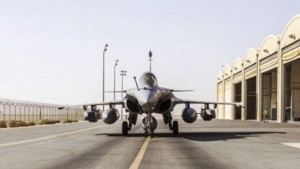2016-01-22 The Russians and the French started to use cruise missiles against ISIS fixed targets starting in December.
For the Russians, President Putin announced in December 2015, that Kalibr cruise missiles had been fired by the submered Rostov-on-Don submarine from the Mediterranean for the first time.
He said TU-22 bombers also took part in the latest raids and that “significant damage” had been done to a munitions depot, a factory manufacturing mortar rounds and oil facilities. Two major targets in Raqqa, the defacto capital of Isis, had been hit, said Mr Shoigu.
President Putin said the new cruise missiles could also be equipped with nuclear warheads – but that he hoped they would never need them.
He said: “With regard to strikes from a submarine. We certainly need to analyse everything that is happening on the battlefield, how the weapons work. Both the [Kalibr] missiles and the Kh-101 rockets are generally showing very good results. We now see that these are new, modern and highly effective high-precision weapons that can be equipped either with conventional or special nuclear warheads.”
For the French, SCALP missiles or Storm Shadow, as they are known by the British, began to be used in December as well.
According to Pierre Tran of Defense News:
The French Air Force fired 12 Scalp cruise missiles during two recent airstrikes, a spokesman for the service said.
The first use of the long-range weapon was Dec. 15, a first since France launched the Chammal mission in September 2014 and the first since the Libyan air campaign in 2011. A second firing of Scalp came on Jan. 2.
France fired 15 Scalp missiles in the Libyan operation, with French media then reporting high unit cost of the weapons and a request for a more selective and restrained use.
With a recent government decision to reduce the stock of Scalp missiles to 100 units to lower costs, the service may have had reason to fire the weapons rather than reduce the inventory, an industry executive said.
France ordered 500 Scalp missiles, 450 for the Air Force and 50 for the Navy, with the latter flying the Rafale from the Charles de Gaulle aircraft carrier.
The initial French strike in December targeted Daesh headquarters, training center and a logistics depot, including some hardened buildings, in the region of al-Qaim, near the border separating Iraq from Syria.
According to MBDA:
Storm Shadow / SCALP is the air-launched long range, conventionally armed, deep strike weapon, designed to meet the demanding requirements of pre-planned attacks against high value fixed or stationary targets.
Able to be operated in extreme conditions, the weapon offers operators a highly flexible, deep-strike capability based around a sophisticated mission planning system.
After launch, the Storm Shadow / SCALP missile descends to a low cruising altitude powered by a turbojet engine.

Guidance is based around a robust triple navigation system that uses Inertial Navigation, GPS (Global Positioning System) and Terrain Reference Navigatation, ensuring that the route selected by the mission planners can be achieved over land and water, even in the most severe counter measures environments.
This three-level system provides the weapon with a high degree of navigational precision. The missile is equipped with an imaging infrared seeker that is activated during the final target approach phase.
Automatic target recognition algorithms then compare the real scene with the target impact point designated during the mission planning phase, in order to hit the target exactly where required. Alternatively an Attack On Co-ordinate capability is available for more time constrained missions.

